How to Use Arrays in Google Sheets
Google Sheets is a powerful tool for managing and analyzing data, but as your spreadsheets become more complex, you may need more advanced tools to perform calculations and analysis.

Google Sheets is a powerful tool for managing and analyzing data, but as your spreadsheets become more complex, you may need more advanced tools to perform calculations and analysis. Arrays are one such feature. This function in Google Sheets allows you to perform complex calculations across multiple cells or ranges of cells. Using arrays in Google Sheets can be daunting for beginners, but with a little practice, they can be a game-changer for managing and analyzing data. In this blog post, we'll take a deep dive into how to use arrays in Google Sheets, from basic formulas to more advanced techniques. Table of Contents Arrays in Google Sheets are used to perform calculations on multiple cells or ranges of cells simultaneously, without having to create a separate formula for each cell. An array formula is a special type of formula that can be used to perform calculations across multiple cells in a column, row, or even across multiple columns and rows. Array formulas are surrounded by curly braces { } and are created by typing the formula and then pressing Ctrl + Shift + Enter (on Windows) or Command + Shift + Enter (on Mac). An array formula is identified by the presence of curly braces { }. The basic syntax of an array formula in Google Sheets is: {formula(range)} "Formula" is any valid formula, and "range" is the range of cells to which the formula should be applied. For example, if you wanted to calculate the sum of the values in cells A1 to A10, you could use the following array formula: =SUM(A1:A10) When you enter this formula as an array formula (by pressing Ctrl + Shift + Enter), Google Sheets will automatically apply the formula to all of the cells in the selected range, producing a single result in each cell. Arrays can also be used with other functions like AVERAGE, MAX, MIN, and COUNT, as well as with logical functions like IF and AND. Using arrays can be a powerful way to perform complex calculations and analyses in Google Sheets. Like many formulas used in Google Sheets, the main benefit of arrays is the ability to work with data faster and more simply. A few of the specific benefits of arrays include: Applying an array to your formula is very straightforward but not very intuitive. Follow these steps to understand how to use an array formula in Google Sheets: Let's say you have a spreadsheet with a list of products and their prices, and you want to calculate the total cost of purchasing a certain number of each product. You could use an array formula to calculate the total cost for each product and the overall cost. Here's how that would work. =ArrayFormula(B2:B6*C2:C6) This formula multiplies the price of each product by the number of units you want to purchase and returns an array of the total cost for each product. =SUM(D2:D6) This formula sums the values in the D2:D6 range to get the total cost of purchasing all the products. While arrays can be a powerful tool for performing complex calculations and analysis in Google Sheets, they can also be resource-heavy and slow down your spreadsheet. Use arrays only when necessary, and try to limit the number of cells they're applied to whenever possible. When editing an array formula, be sure to press Ctrl + Shift + Enter (on Windows) or Command + Shift + Enter (on Mac) to apply the changes. If you don't use this key combination, the formula may not work correctly. Instead of using cell references in your array formulas, consider using named ranges. This can make your formulas easier to read and understand. Before using an array formula in your spreadsheet, test it on a small set of data to make sure that it's working correctly. This can help you avoid errors and mistakes that can occur when working with large amounts of data. If your array formula is likely to return an error, consider using the IFERROR function to display a more user-friendly message instead. For example, you could use "=IFERROR(array formula, "No data available")" to display the message "No data available" if the formula returns an error. To make it easier to understand and troubleshoot your spreadsheet in the future, consider documenting your array formulas with comments or by using cell notes. This can also be useful if someone else needs to work with your spreadsheet. Using arrays in Google Sheets is particularly useful if you’re working with large datasets or complex formulas that need to be linked together. Although executing arrays is simple, it’s important to be careful and document how and where you’ve used them. That way, if you start getting errors on calculations, you’ll have a clear path to working backward and figuring out what went wrong.
What do arrays do in Google Sheets?
The Benefits of Using Arrays in Google Sheets
How to Use Arrays in Google Sheets
Google Sheets Array Example
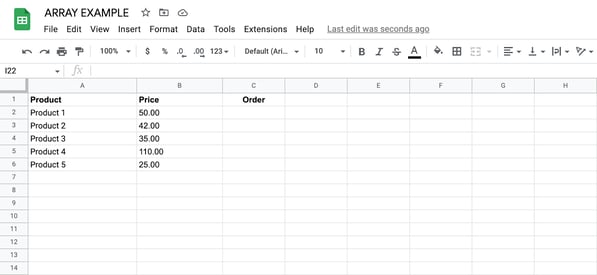 In cell C1, enter the number of units you want to purchase for each product. For example, if you want to purchase three units of Product 1, two units of Product 2, and four units of Product 3, you would enter "3" in cell C2, "2" in cell C3, and "4" in cell C4.
In cell C1, enter the number of units you want to purchase for each product. For example, if you want to purchase three units of Product 1, two units of Product 2, and four units of Product 3, you would enter "3" in cell C2, "2" in cell C3, and "4" in cell C4.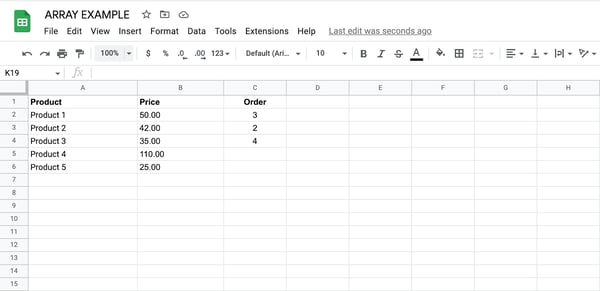 In cell D1, enter the following formula:
In cell D1, enter the following formula: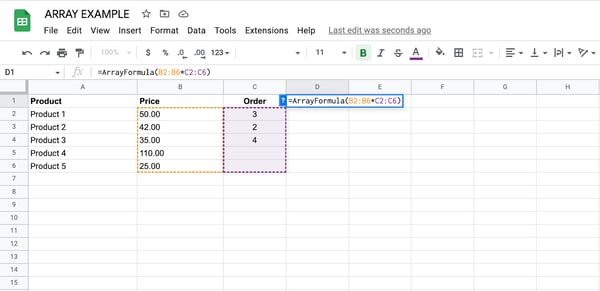
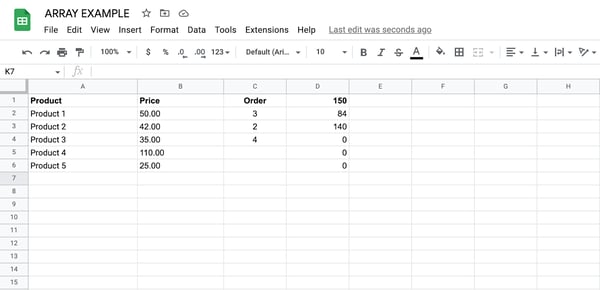 Finally, in cell D7, enter the following formula:
Finally, in cell D7, enter the following formula: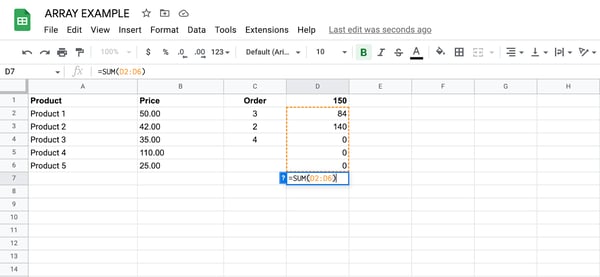
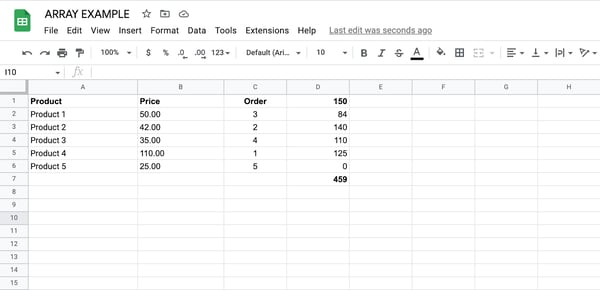 That's it! Now, as you update the values in column C, the array formula in column D will automatically recalculate the total cost for each product, and the SUM formula in cell D6 will update to reflect the overall cost. This can be a very useful tool for managing and analyzing data in Google Sheets.
That's it! Now, as you update the values in column C, the array formula in column D will automatically recalculate the total cost for each product, and the SUM formula in cell D6 will update to reflect the overall cost. This can be a very useful tool for managing and analyzing data in Google Sheets.
Best Practices for Using Arrays
Use arrays only when necessary.
Be careful when editing arrays.
Use named ranges.
Test your formulas.
Use the IFERROR function.
Document your formulas.
Getting Started

 KickT
KickT ![Google Sheets Templates [Free Kit]](https://no-cache.hubspot.com/cta/default/53/e7cd3f82-cab9-4017-b019-ee3fc550e0b5.png)































![Run An Ecommerce SEO Audit in 4 Stages [+ Free Workbook]](https://api.backlinko.com/app/uploads/2025/06/ecommerce-seo-audit-featured-image.png)

